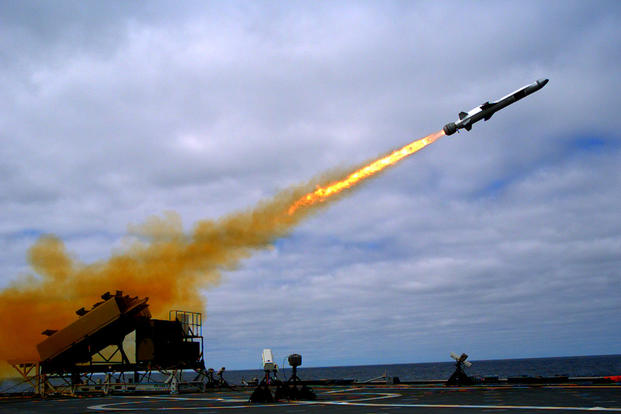 With the explosive roar of multiple missiles and white contrails arcing high into the sky, U.S. and Japanese forces made history Thursday during Rim of the Pacific exercises. And set the stage for what a future conflict with China might entail. The Army fired a Naval Strike Missile from a truck at the Pacific Missile Range Facility and hit a decommissioned ship at sea 63 miles north of Kauai. Ally Japan fired its own truck-mounted Type 12 anti-ship missiles at the tank landing ship Racine -- at one point in a salvo with five practice U.S. High Mobility Artillery Rocket System missiles, also truck-mounted. Gen. Robert Brown, commander of U.S. Army Pacific at Fort Shafter, said it was the first time Japanese Ground Self-Defense Force missiles were under by U.S. fire control while working with U.S. forces including the Army, Navyand Air Force to target a ship.
With the explosive roar of multiple missiles and white contrails arcing high into the sky, U.S. and Japanese forces made history Thursday during Rim of the Pacific exercises. And set the stage for what a future conflict with China might entail. The Army fired a Naval Strike Missile from a truck at the Pacific Missile Range Facility and hit a decommissioned ship at sea 63 miles north of Kauai. Ally Japan fired its own truck-mounted Type 12 anti-ship missiles at the tank landing ship Racine -- at one point in a salvo with five practice U.S. High Mobility Artillery Rocket System missiles, also truck-mounted. Gen. Robert Brown, commander of U.S. Army Pacific at Fort Shafter, said it was the first time Japanese Ground Self-Defense Force missiles were under by U.S. fire control while working with U.S. forces including the Army, Navyand Air Force to target a ship.
"First time ever in history. That's pretty unique," Brown said while visiting the launch site.
Former U.S. Pacific Command chief Adm. Harry Harris said in 2016 that "countries like China, Iran and Russia are challenging our ability to project power ashore, from the sea, through ever-more sophisticated anti-ship missiles."
One way to counter that is by rapidly deploying ground-based, truck-mounted long-range missiles to target enemy ships as another option, in addition to U.S. Navy and Air Force capabilities.
"It's like an unsinkable aircraft carrier" in the Pacific, Brown said.
Armed forces can reload and restock anti-ship missiles on land, moving the launchers to minimize detection.
It all fits into what's known as multi-domain battle, which seeks new levels of cooperation and data sharing among the Army, Navy, Air Force and Marinesacross land, air, maritime, space and cyberspace to exploit windows of opportunity on a rapidly moving battlefield.
China's massive military modernization means it would take significant resources to deter them and, if a conflict breaks out, to defeat them, said retired Navy Capt. Carl Schuster, former director of operations for Pacific Command's Joint Intelligence Center and now an adjunct professor at Hawaii Pacific University.
"The dilemma we face is, we either have to develop new, innovative, integrated approaches to dealing with these problems -- and add as many (partner nations) as we can get," Schuster said, "or we bankrupt ourselves pursuing it."
A Japanese P-3 Orion aircraft was in the air Thursday to acquire the target, but there were communication problems, so a Gray Eagle unmanned aerial vehicle paired with an Army AH-64 Apache helicopter did the job, said Col. Christopher Wendland, the Multi-Domain Task Force pilot program commander.
The Gray Eagle communicated with the Apache, which handed off the information to an Army ground station, which sent the information to the Japanese and U.S. missile systems.
Japan fired four Type 12 missiles, and all hit the target ship, the Navy said.
Wendland said he believed it was the first time the Army fired the Naval Strike Missile, developed by Norway's Kongsberg Gruppen and provided in partnership with Raytheon. The missile has a 115-mile range.
Australia, Japan and the United States participated in Thursday's "sink exercise."
The Pearl Harbor submarine USS Olympia (SSN 717) fired a Harpoon missile and an MK-48 torpedo at the 522-foot retired tank landing ship, which sunk in 15,000 feet of water at about 8 p.m., one hour after the torpedo hit, the Navy said.
This year marked the first time a Royal Australian Air Force P-8A aircraft participated in a sink exercise, firing a Harpoon.
Adm. Phil Davidson, commander of U.S. Indo-Pacific Command on Oahu, suggested a big role for the Army in future maritime operations.
"As (U.S.) Naval forces drive our enemies into the (near-shore waters), Army forces can strike them," Davidson said in a release. "Conversely, when the Army drives our enemies out to sea, Naval firepower can do the same."
No comments:
Post a Comment